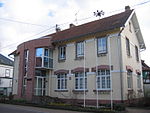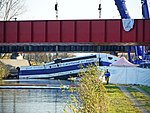On 14 November 2015, a TGV train derailed in Eckwersheim, Alsace, France, while performing commissioning trials on the second phase of the LGV Est high-speed rail line, which was scheduled to open for commercial service five months later. The derailment resulted in 11 deaths among those aboard, while the 42 others aboard the train were injured. It was the first fatal derailment in the history of the TGV and the third derailment since the TGV entered commercial service in 1981.The test train was traveling eastbound on the southern track when it entered a curve at 265 km/h (165 mph)—90 km/h (56 mph) over its assigned speed—causing the rear bogie of the lead power car to derail to the left (outside of curve) due to centrifugal forces. The lead power car separated from the rest of the train, and the rear of the lead power car struck the concrete parapet on the abutment to a bridge over the Marne–Rhine Canal. The power car slid along the left parapet of the bridge and overturned, sliding down the embankment and coming to rest 150 m (490 ft) beyond the end of the bridge. Cars 2–7 derailed before the bridge and travelled off the embankment with enough inertia to overshoot the canal, coming to rest 80–130 m (260–430 ft) beyond the beginning of the bridge.: 21 Cars 8–9 came to rest on the east bank of the canal and the rear power car ended up partially submerged in the canal. According to investigators, late braking, which led to the train entering the curve at excessive speed, was the immediate cause of the accident. Criminal and technical investigations are ongoing. French national rail operator SNCF suspended test trials at high speeds until the lessons learned from the investigation were integrated into testing process. The scheduled opening of the second phase of the LGV Est for commercial service was delayed three months, from 3 April 2016 to 3 July 2016.












